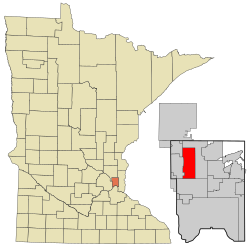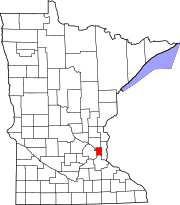Arden Hills, Minnesota
Arden Hills, Minnesota | |
|---|---|
 Location of Arden Hills, Minnesota | |
| Country | United States |
| State | Minnesota |
| County | Ramsey |
| Incorporated | 1951 |
| Area | |
| • Total | 9.6 sq mi (24.9 km2) |
| • Land | 8.9 sq mi (23.0 km2) |
| • Water | 0.7 sq mi (1.9 km2) |
| Elevation | 938 ft (286 m) |
| Population (2000) | |
| • Total | 9,652 |
| • Density | 1,087.3/sq mi (419.8/km2) |
| Time zone | UTC-6 (Central (CST)) |
| • Summer (DST) | UTC-5 (CDT) |
| ZIP code | 55112 |
| Area code | 651 |
| FIPS code | 27-02026Template:GR |
| GNIS feature ID | 0639428Template:GR |
| Website | www.ci.arden-hills.mn.us |
Arden Hills is a city in Ramsey County, Minnesota, United States. The population was 9,652 at the 2000 census. Bethel University and Seminary is located in the city of Arden Hills. Also, the campus of Northwestern College is partially in Arden Hills. The headquarters of Catholic Aid Association, a fraternal benefits society, are located here as well.
In July 2006 the city reached a tentative agreement with the U.S. Government to purchase a large portion of the former Twin Cities Army Ammunition Plant site for $45 million, a deal that could lead to a major new development that would include 2,400 new homes and 3,200,000 square feet (300,000 m2) of commercial space.
Water
Arden Hills purchases its water from Roseville, which purchases its water from the Saint Paul Regional Water Services.
Geography
According to the United States Census Bureau, the city has a total area of 9.6 square miles (24.9 km²), of which, 8.9 square miles (23.0 km²) of it is land and 0.7 square miles (1.9 km²) of it (7.60%) is water.
Interstate Highway 35W, Interstate Highway 694, U.S. Highway 10, Minnesota Highway 51, and County Highway 96 are five of the main routes in the city.
Demographics
As of the censusTemplate:GR of 2000, there were 9,652 people, 2,959 households, and 2,228 families residing in the city. The population density was 1,087.3 people per square mile (419.7/km²). There were 3,017 housing units at an average density of 339.9/sq mi (131.2/km²). The racial makeup of the city was 92.81% White, 1.32% African American, 0.20% Native American, 3.64% Asian, 0.04% Pacific Islander, 0.54% from other races, and 1.46% from two or more races. Hispanic or Latino of any race were 1.36% of the population.
There were 2,959 households out of which 33.6% had children under the age of 18 living with them, 63.6% were married couples living together, 8.9% had a female householder with no husband present, and 24.7% were non-families. 19.9% of all households were made up of individuals and 8.1% had someone living alone who was 65 years of age or older. The average household size was 2.59 and the average family size was 2.98.
In the city the population was spread out with 20.0% under the age of 18, 20.3% from 18 to 24, 20.6% from 25 to 44, 25.2% from 45 to 64, and 13.9% who were 65 years of age or older. The median age was 36 years. For every 100 females there were 85.3 males. For every 100 females age 18 and over, there were 81.6 males.
The median income for a household in the city was $64,773, and the median income for a family was $72,236. Males had a median income of $52,464 versus $38,906 for females. The per capita income for the city was $29,609. About 1.8% of families and 3.9% of the population were below the poverty line, including 4.4% of those under age 18 and 0.8% of those age 65 or over.
Education
The following institutions are located in Arden Hills:
- Bethel University
- Northwestern College (Minnesota) (The northern portion of the campus is located in Arden Hills, while the southern portion is in Roseville, Minnesota.
Mounds View High School is a public Grade 9-12 school; it is one of two high schools in Independent School District 621; the other is Irondale High School.
Valentine Hills is the only elementary school in the city of Arden Hills; it is one of six elementary schools in Independent School District 621.
Valentine Hills has had a prestigious history of mathematics under instructor Lee Porath. In the 2003-2004 school year, the Valentine Hills fifth grade Math Masters team claimed the state championsip as well as placing remarkably high in the standings of Math Olympiads, a series of tests for elementary and middle school students. Bel Air Elementary School, led by Mike Barton, had a cast of academic all stars who competed heavily against Valentine Hills who was led by Joe Eisenmenger, master of the calculator and slayer of equations. He is currently attending Mounds View High School and still slaying equations.
Land Use
Any new development is expected to conform to the provisions of the very detailed (and sometimes contradictory) provisions of the Zoning Code, the primary stated purpose of which is to ensure fair application of City development regulations and to promote the public health, safety, and welfare.
Proposed deviations from the Zoning Code require the approval of a "variance" by the City Council, which takes into consideration the recommendations of the Planning Commission, staff, and members of the public. Requests for variances are required to address the criteria in Minnesota State Statutes 462.357 Subd. 6. Variances are intended to be used to address unique lot situations when the literal application of the Code would restrict reasonable use of the land and create an undue hardship as defined in Minnesota State Statutes. The undue hardship cannot be created by the landowner or be based entirely on economic reasons. Variance applications are reviewed by the Planning Commission, which is responsible for determining what constitutes "undue hardship."
Members of the Planning Commission are appointed by the City Council. Commission members are to represent the interests of the community and evaluate development applications based on established City Codes and State Statutes. Planning Commission members must be City residents, and they are unpaid volunteers.
Environmental Protection
The City has a Shoreland Ordinance, which is typical of communities in Minnesota with lakes. The text of the Ordinance states that uncontrolled use of shorelands of the City affects the public health, safety and general welfare not only by contributing to pollution of public waters. The purpose of the ordinance is to protect the public health, safety, and welfare and to provide for the wise development of shorelands of public waters. The Minnesota Legislature has delegated responsibility to the municipalities of the State to regulate the subdivision, use and development of the shorelands of public waters, and thus preserve and enhance the quality of surface waters, preserve the economic and natural environmental values of shorelands, and provide for the wise utilization of waters and related land resources. The State has not, however, required that the delegated responsibility be exercised with respect to enforcement of the corresponding laws, ordinances, and regulations, nor does the State require that the municipality have an established administrative sanction (fine) process at its disposal for the punishment of violators.
The City is located within the Rice Creek Watershed District. In its effort to minimize storm water runoff, the District encourages minimization of impervious surfaces in developed areas.
References

